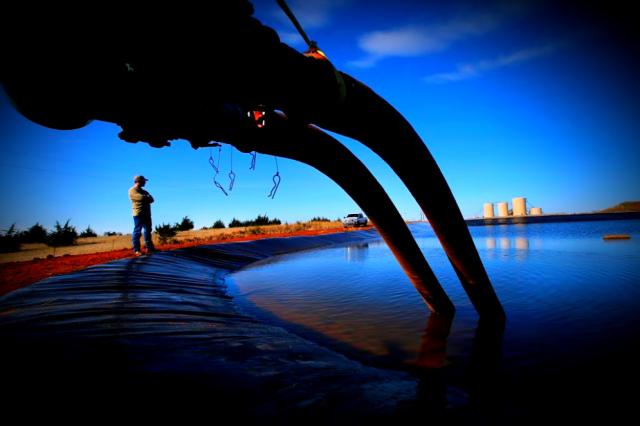
Lines feeding into a freshwater frac tank in Kingfisher County, Okla. (Source: Hart Energy)
[Editor's note: This story originally appeared in the March 2020 edition of E&P. Subscribe to the magazine here.]
It is an inorganic, odorless, tasteless, transparent and nearly colorless chemical compound supporting most organic forms of life. It covers more than 70% of the Earth’s surface, and it supports the economies of all 195 countries on the planet. It is water.
The petroleum industry has long used it for a variety of purposes and produced it as a black gold byproduct. A long-held rule of industrial thumb is that up to 10 bbl of water are produced for every 1 bbl of oil. The rapid growth of unconventional resource plays across the U.S., particularly in the home of an ancient sea now known as the Permian Basin, has delivered with it not only barrels upon barrels of produced water but also a host of new technologies to effectively manage and meet water demands.
When I first started covering oil and gas technologies for E&P in 2012, the challenge of the day was water sourcing, as severe drought conditions in Texas and Oklahoma placed a pinch on the public’s freshwater supplies, with the spotlight shining brightly on the industry’s water use in hydraulic fracturing operations. Identifying alternatives to freshwater was the task of the day.
Devon Energy, for example, began recycling water in 2004 in the first U.S. shale play, the Barnett. When the company drilled its first well in Oklahoma’s Cana Woodford Shale play in 2008, company officials found that the flowback water was sufficiently low in salt content and could be reused without needing extensive treatment. The company built a water recycling facility in the area that, in the first three months of its operation in 2012, saved more than 1 MMbbl of water.
Those efforts continue today in its Delaware Basin operations in southeastern New Mexico, where Devon has reused 21 MMbbl of water in the four years, according to the company’s website. Reused and brackish water account for more than 80% of the company’s operations. Eight impoundment basins—each 15 ft deep and covering four acres—connected by a network of pipelines were built to store and transfer water, eliminating the need to haul away 500 truckloads of produced water each day.
From those early days of shale, the business of water management has grown significantly. According to Bluefield Research, water management spend for hydraulic fracturing is forecast to average $17 billion per year from 2019 through 2028.
“Water management does not just start and stop at the frac, which underpins the recent growth in the midstream water management and a wave of investment from 30-plus private-equity and financial firms,” said Reese Tisdale, president of Bluefield Research, in a release. “The significant share of transport costs to the industry has ushered in more than 57 water management firms—pure-play water players, energy services companies and technology promoters—along the industry value chain.”
In this month’s E&P issue, this value chain is examined, trends are discussed, challenges are analyzed and the technologies making water more manageable are featured. The days of “three pipes in a ditch” have evolved to 300 pipes networked to central hubs strategically placed with automated operations and remote monitoring made possible by data rapids flowing to and fro. The industry has come far in seven years, but there is still much ground left to cover in the decade ahead.
Recommended Reading
Occidental Temporarily Reduces Warrants Price to Raise $1.6B
2025-03-03 - Occidental Petroleum’s offer to warrant-holders at a reduced exercise price of $21.30 would raise $1.6 billion, the company said.
Dividends Declared Week of Feb. 24
2025-03-02 - As 2024 year-end earnings wrap up, here is a compilation of dividends declared from select upstream and midstream companies.
Q&A: Patterson’s OFS Perspective on the Shale Boom, Pandemic and Current Upswing
2025-02-27 - Former Basic Energy Services CEO Roe Patterson details his perspective on the shale boom and the lessons learned to get back to the current upswing in the industry.
2025 Pinnacle Award: Christine Ehlig-Economides is a Pioneer in the Field and Classroom
2025-02-27 - University of Houston petroleum engineering professor Christine Ehlig-Economides has left an indelible mark on the industry and blazed a trail for women.
Comments
Add new comment
This conversation is moderated according to Hart Energy community rules. Please read the rules before joining the discussion. If you’re experiencing any technical problems, please contact our customer care team.




